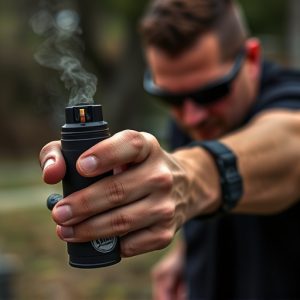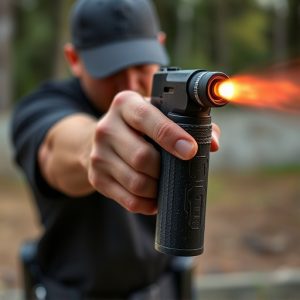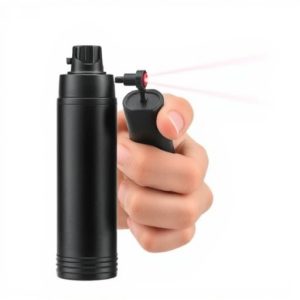Mastering Self-Defense: Pepper Spray’s Role in Facial Defense Strategies
In emergency situations involving pepper spray, immediate action is key. Rinse affected areas with w…….
In emergency situations involving pepper spray, immediate action is key. Rinse affected areas with water for at least 15 minutes, wipe skin gently, and move to fresh air. Medical attention may be needed for severe symptoms. Pepper spray devices target attackers' eyes and respiratory systems via capsaicin. Local laws govern carrying such devices; understanding regulations is crucial. Choose products designed to neutralize pepper spray on the face, focusing on key active ingredients and brand reputation. Aim close-range bursts at the face to temporarily blind and disorient an attacker, providing escape time.
“Uncover the power of self-defense with our comprehensive guide to inflammatory spray devices. Learn how pepper spray, a powerful tool for personal safety, works its magic on the face, neutralizing attackers effectively. Explore the science behind these devices and understand their legal standing.
From choosing the right spray to mastering strategies for maximum impact, this article equips you with knowledge. Discover key features to ensure your safety and learn how to employ pepper spray to neutralize potential threats, giving you confidence in high-risk situations.”
- Understanding Pepper Spray and Its Effects on the Face
- The Science Behind Self-Defense Inflammatory Spray Devices
- Legal Considerations and Regulations for Carrying Pepper Spray
- Choosing the Right Self-Defense Spray: Key Features to Look For
- Effective Strategies for Using Pepper Spray to Neutralize an Attacker's Grip
Understanding Pepper Spray and Its Effects on the Face
Pepper spray, a popular self-defense device, uses capsaicin, the same compound that makes chili peppers spicy. When deployed, it creates an intense burning sensation and temporarily blurs vision, disorienting attackers. The effects on the face are particularly strong due to the high concentration of sensitive nerve endings in this area. Upon exposure, eyes water, nose and sinuses become congested, and breathing can be hindered, causing coughing or difficulty catching one’s breath.
To neutralize pepper spray on the face, immediate action is crucial. Rinse affected areas with large amounts of clean water for at least 15 minutes to dilute the capsaicin. Gently wipe the skin with a soft cloth or towel to remove any residual spray. Seek fresh air if possible, and wash clothes that may have come into contact with the spray separately from other items to prevent cross-contamination. Medical attention might be necessary if symptoms persist or worsen, as pepper spray can cause severe discomfort and even respiratory distress in certain individuals.
The Science Behind Self-Defense Inflammatory Spray Devices
Self-defense inflammatory spray devices, often referred to as pepper spray, work by neutralizing an attacker’s eyes and respiratory system. The active ingredient in these devices is capsaicin, a chemical compound found in chili peppers. When sprayed, capsaicin irritates the mucus membranes, causing tears, congestion, coughing, and difficulty breathing. This temporary disability gives the user precious time to escape or defend themselves further.
The device’s design plays a crucial role in its effectiveness. A typical inflammatory spray is contained in a small, easily portable canister that allows for quick deployment. The spray pattern is precisely engineered to cover a specific range, ensuring maximum impact while minimizing the risk of off-target effects. Additionally, advancements in technology have led to improved formulations that offer longer-lasting protection and better resistance against harsh weather conditions.
Legal Considerations and Regulations for Carrying Pepper Spray
Carrying and using a self-defense inflammatory spray device, such as pepper spray, comes with a range of legal considerations. The regulations vary significantly across different jurisdictions, so it’s crucial to understand the local laws before purchasing or carrying any form of self-defense spray. Many areas have specific restrictions on who can possess and use these devices, as well as where and how they can be carried. For instance, some regions may require a permit or license for pepper spray ownership, while others might restrict its use to law enforcement or trained individuals.
When it comes to neutralizing pepper spray on the face, legal restrictions play a vital role. In many places, using pepper spray against another person is only permitted in self-defense situations, and the force applied must be proportional to the perceived threat. Misusing or overusing pepper spray can result in serious consequences, including civil liability for assault and battery. Additionally, the way an individual responds to exposure to pepper spray—which can cause temporary blindness, coughing, and difficulty breathing—is a factor that legal systems consider when determining the legality of its use.
Choosing the Right Self-Defense Spray: Key Features to Look For
When selecting a self-defense inflammatory spray device, understanding its features is crucial for effective and safe use. Look for products designed to neutralize pepper spray on face, as this can quickly deescalate dangerous situations. Active ingredients like capsaicin or oleoresin capsicum (OC) are key; they irritate the eyes and respiratory system, providing time to escape. The concentration of these ingredients varies; higher concentrations offer more protection but may increase potential side effects.
Other important features include ease of use, as you want a spray that deploys quickly and reliably in stressful situations. Size and weight are also considerations – smaller, lightweight devices are easier to carry discreetly. Additionally, check for weather-resistant designs if you plan on using it outdoors. Always opt for reputable brands with proven track records for quality and effectiveness.
Effective Strategies for Using Pepper Spray to Neutralize an Attacker's Grip
When faced with an attacker, effectively using a self-defense inflammatory spray device like pepper spray can be a game-changer. To neutralize an attacker’s grip, aim for their face—the eyes, nose, and mouth are particularly vulnerable areas. The intense irritation caused by the spray will temporarily blind, disorient, and disable them, giving you precious time to escape or call for help.
Remember that proper application is key; hold the canister at close range (3-5 inches) and spray in short bursts into your attacker’s face. Be prepared for a strong reaction—they may drop their grip instantly or try to shield their face, so be ready to move quickly and safely away once you’ve deployed the spray.
In conclusion, self-defense inflammatory spray devices, including pepper spray, offer a powerful tool for individuals seeking to neutralize potential threats and protect themselves. Understanding the science behind these devices, their legal considerations, and effective usage strategies is crucial. By choosing the right spray with key features designed for maximum impact and applying proven techniques to neutralize an attacker’s grip, users can enhance their safety in various situations. Remember, knowledge and preparation are essential in ensuring your well-being when faced with a dangerous encounter.


